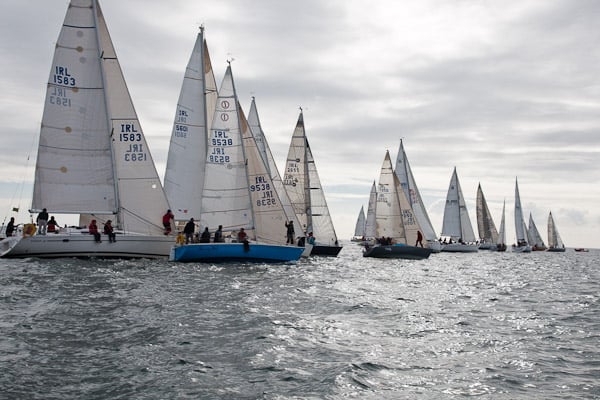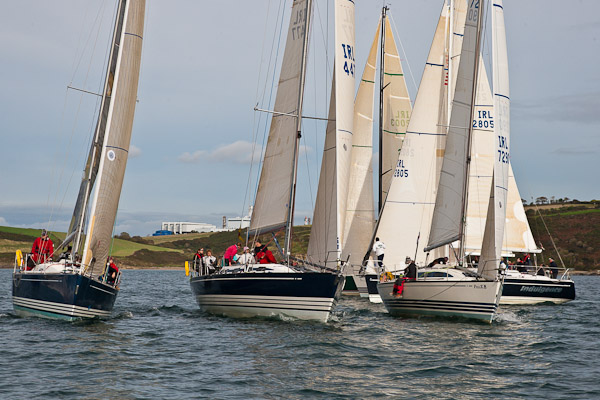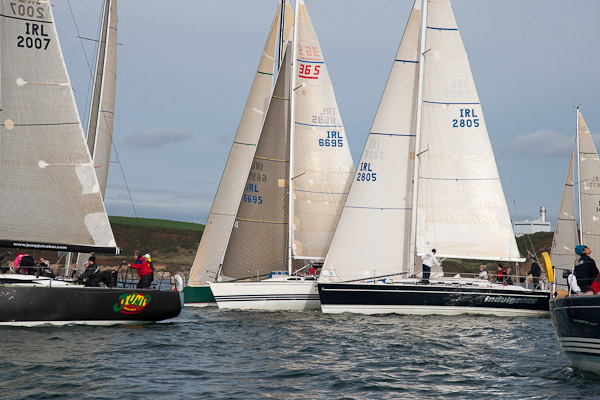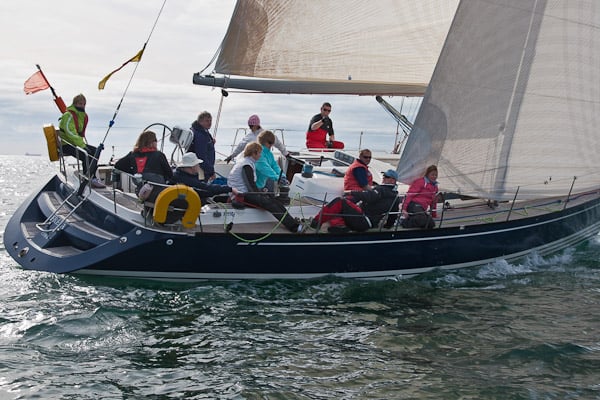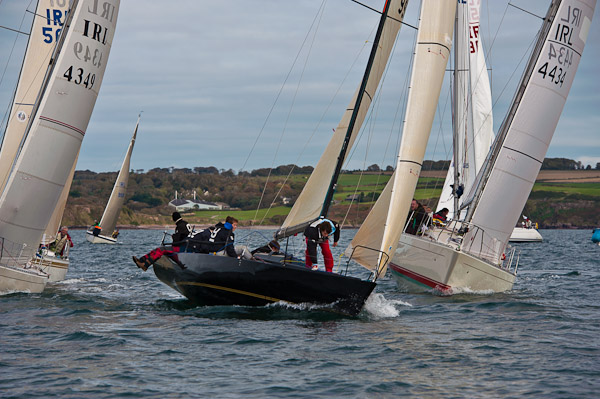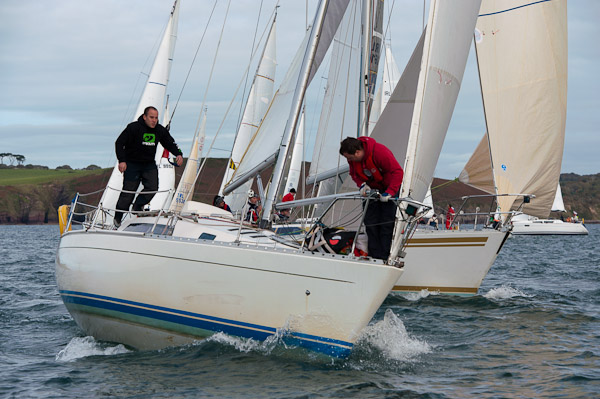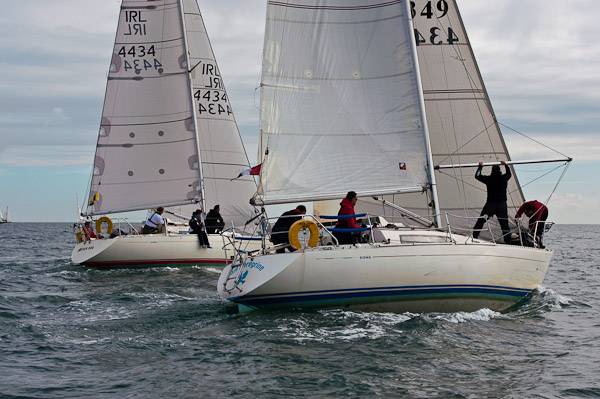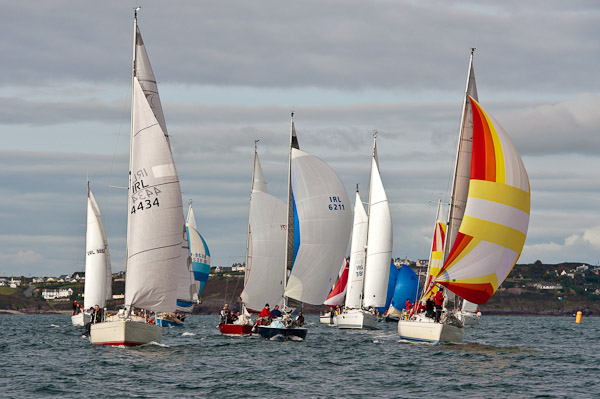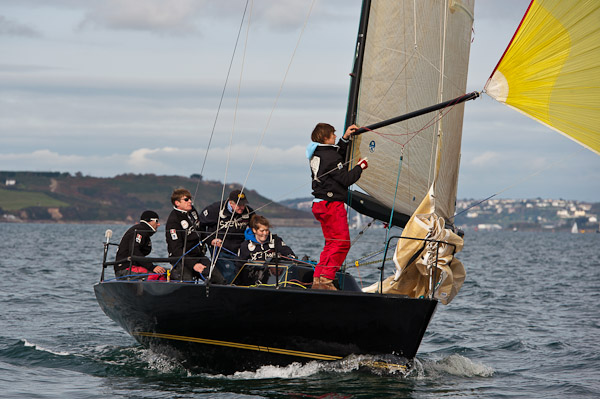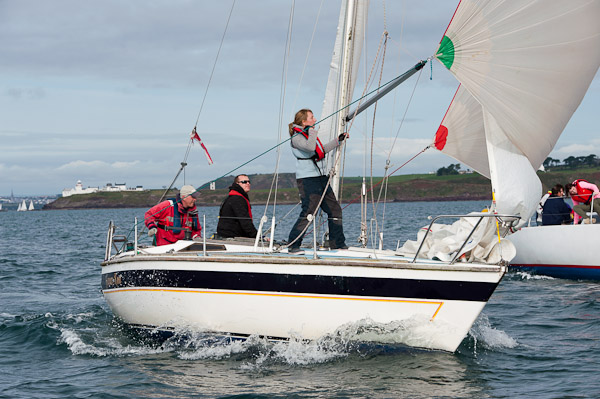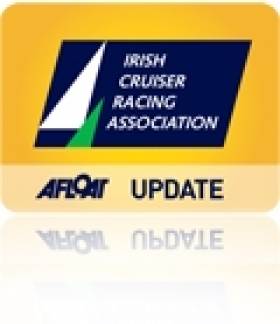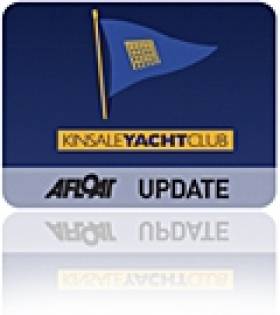Displaying items by tag: Bob Bateman
National 18s Make Special Award to Photographer Bob Bateman
The National 18 class has shown its appreciation to Cork Harbour-based photographer Bob Bateman for his 'outstanding support' of the dinghy class at its end of season meeting.
Bateman, who is assisted by Mary Malone on many of his waterborne assignments were awarded the National 18s Sullivan Trophy for their role in capturing the action at significant National 18 regattas that in 2021 included Royal Cork's 300th celebrations.
Contributing so much to the success of Afloat.ie on the south coast, Bateman has captured many important occasions with his colourful images of Cork maritime life.
"Bob and Mary were out for every event for the class taking photos and writing up event reports. The class is hugely grateful for their support", National 18 Class Captain Charles Dwyer told Afloat.
The trophy was presented at the National 18s end of season River Race. The sailors applauded Bateman and Malone for their work in documenting the success of the three-person dinghy class and helping to preserve its history.
Breeze up for Royal Cork CH Marine Autumn League Race
Last week may have produced conditions lulling us all into a mood of ‘A Season of Mists and Mellow Fruitfulness’ but today sharply reminded the Royal Cork Yacht Club Autumn League competitors of the march on of the season writes Claire Bateman. To day was a gray day with a bite in the wind that came from the E/SE producing 15/20 knots with occasional gusts into the mid twenties. Skies were dark with occasional shafts of sunlight but none of this deterred the enthusiastic sailors as they set out all geared up for the weather.
Even as your scribe was heading out for the start there was already a 1720 limping home with a broken mast a sure indicator there might be a few more incidents to come and such turned out to be the case. The tales in the club bar afterwards were stories of crew overboard, torn sails, gear damage and protests. One of the Archambauld 35s was seen to be doing something akin to the dance of the seven veils off the Holy Ground at Cobh, fine girl you are!!

All in all it was an extremely busy day for all the willing volunteers who help with the running of the events, the working out of handicaps and all that is necessary for the smooth operation of racing.
There was a short sharp sea as there was an ebb tide going in the opposite direction to the wind making for exhilarating racing if a little uncomfortable for some of the smaller boats at times. A full complement of racing was achieved for the day and so far four races have been held in the CH Marine series and racing will continue next Sunday
Sunny Sailing off Kinsale (Photos here!)
Glorious sailing conditions prevailed for the second day of the Kinsale Cruiser Spring Series yesterday writes Claire Bateman. Scroll down for Bob Bateman's sailing photos of yesterday's cruiser action. The only sailing factor missing was the wind! However but after a wait of two and a half hours, the breeze filled in from the south- west giving some 15 knots and enabling racing to commence. Classes 0, 1 and 2 sailed the round the cans course, Classes 3 and 4 were on the windward leeward course and the White Sail Fleet sailed in the harbour. To add to the spectacle the Optimist dinghies in large numbers were sailing further east in trials for international competition.
Sovereigns Cup Aiming for 140 Entries
Entries are coming in at a good pace for The Sovereign's Cup the South coast sailing event takes place from 22nd-25th June 2011 in the outer harbour of Kinsale, Co Cork.
"We are delighted with the entry level to date and are now encouraging boats to enter The Sovereign's Cup on our website www.sovereignscup.com or by calling Kinsale Yacht Club directly on (021) 4773433. Already, skippers are beginning to plan their sailing events for the year and we hope that they will favourably consider us here in Kinsale," said Gary Horgan, Regatta Director.
"Additionally, this year, the Dun Laoghaire to Dingle race and ICRA Championships in Cork just before The Sovereign's Cup should act as good feeders as boats will be down south. As well as the excellent sailing conditions, race management and social programme ashore, there is a good discounted entry fee for the first 100 entries, which is already proving very attractive to entrants. Also, we are encouraging people to start thinking about their travel and accommodation plans and are delighted that the Cork Swansea ferry will enable more sailors to access Kinsale easily from the UK," he added.
The Sovereign's Cup was established in 1995 as and has been a very successful and hugely popular cruiser regatta. The biennial event attracts over 140 boats from all over Ireland and the UK who compete for the prestigious Sovereign's Cup for best all round score in IRC and The Portcullis Trophy for best progressive handicap.
There are many Classes for entry; including Class 0, 1, 2, 3, 4 and two White Sails classes. Also, the Quarter Ton Class Championships will be taking place during the Sovereign's Cup, bringing many new visitors to Kinsale from the South of England and Wales in particular.
According to Ian Travers of the Sovereign's Cup Committee at KYC, interest has been phenomenal and he has received plenty of calls from UK and Irish owners expressing their interest.
"Also, I have received confirmation that a quarter tonner named 'Black Fun' is to be shipped from New Zealand to Europe this year and is intent on making it to Kinsale for the Sovereign's Cup! We are confident that there will be around 25-30 quarter tonners participating in the Sovereign's Cup this year," said Ian Travers.
For more information on The Sovereign's Cup, contact Kinsale Yacht Club on (021) 4773433 www.kyc.ie or www.sovereignscup.com
Take a look back at Bob Bateman's photos from Sovereigns Cup 2003, Sovereigns Cup 2005 and Sovereigns Cup 2007 in our photo reviews
Click this link for all the lastest Sovereigns Cup news from Afloat.ie
Big Turnout for Scora Meet (PHOTO Review HERE)
The members having been welcomed by Kinsale Vice Commodore Cameron Good, the meeting got under way with the first business of the evening being to elect a new Commodore. Vinnie O'Shea of Royal Cork Yacht Club was an unopposed unanimous choice and then took the chair. Jackie Kenefick of Schull Harbour Sailing Club was elected Executive Officer of the Association and Michael Murphy of RCYC and SHSC agreed to remain in his role of Treasurer and PRO. Also in attendance at the top table was Denis Kiely the hard working National Handicapping Officer.
The agenda item on class bands as was expected provoked lively input from the members, in fact the debate looked like going on for the evening such was the interest until the Chairman advised the members that he would shortly be calling a meeting with just one item on the agenda and that would be the class bands and handicapping.
A digital slide show of summer sailing was presented by Bob Bateman (SEE BELOW) just before there was a break for refreshments and then the eagerly awaited presentation of trophies and prizes took place. The prizes were presented by Sue McWilliam of McWiliam Onesails and Hugh Mockler of HM Yachts Ltd. and the SCORA prizes consisting of framed photographs from the 2010 sailing season were presented by the newly elected Commodore, Vinnie O'Shea.
SCORA Meet to Discuss the State of South Coast Sailing
The 2010 Annual General Meeting and Prizegiving of the South Coast Offshore Cruising Association (SCORA) will take place at Kinsale Yacht Club on Friday December 3rd at 8pm.
Hugh Mockler of HM Yachts will present the League prizes for the eighteen race series that included the Kinsale April league and the Royal Cork Autumn League.
Des Mc William of McWilliam One Sails will present the championship prizes for the series that was sailed in Cobh in September.
The SCORA Committee will present a series of sailing action photographs from the various events covered by Sailing Photographer Bob Bateman during the season.
The meeting will discuss the state of sailing on the South Coast and the ongoing development of the Echo progressive handicap system, together with the possible movement of class bands.
At the close of the sailing season an interesting evening is assured so all sailors are urged to attend and avail of the opportunity to air their views on the handicap system and the class bands.
French Van Promotes Great Week of Irish Sailing
It's a great looking team sailing van, a brilliant advert for Irish sailing and an amazing photo of a TP52, planing like a dinghy in Cork harbour! The French Paprec Recylage Sailing Team have had their entire sailing van decorated with a dramatic Bob Bateman picture from Cork week 2010. The photos of the event HERE were a highlight of the 2010 season.

Latest Photos From Royal Cork's October League
Bob Bateman's latest photos from yesterday's Royal Cork's October League are over the fold. Having sailed six races in the O'Flynn Exhams Autumn League and, with a discard applied, a trend is emerging writes Claire Bateman. The exception to this is White Sail 1 and 2 who have had four races and at the wish of the classes have reverted to two races each day. It was another light day with yachts waiting patiently for the breeze to fill and when it did it was a light breeze from the west going further into the south as the day went on. Richard Leonard's Green Fleet were on a laid course outside the harbour and having postponed the first race during the start sequence, he eventually got the fleet going when the west breeze settled. Class Three and White Sail 1 were started together followed by Class Four and White Sail 2. The mixing of classes made for interesting racing as it kept the boats in close proximity to one another and a second race was sailed successfully thereafter.
On David O'Brien's harbour course with the Red Fleet the breeze was slower to fill in. However, when it did Class 2 and the 1720s were sent on a course to Ringabella against the flood tide. The Class Zero and Class One fleets were over eager and suffered a general recall so they started last. Again they were over anxious and were bunched at the pin end of the line but after some manoeuvering a clear start was called and they too set off for Ringabella, the boats heading for the western shore to avoid the tide faring best. First to reach Ringabella was Jump Juice but she obviously didn't feel like leaving as she clung to the mark having to suffer the fate of watching many of the class rounding before she eventually got free. In Class One IRC Donal O'Leary's D-Tox is on 7 points but David Scott's EOS is on 20 points with Michael Wallace just one point adrift on Felix.
The position in Class Three IRC appears to be the most obvious with the prowling Kenefick/O'Brien Tiger leading with five first places followed by Ian Traver's Bandit on 9 points and in Class Zero IRC the same equally obvious situation pertains with Kieran Twomey's Gloves Off on 5 points and Conor Phelan's Jump Juice on 9 points. In Class Four IRC Mike Sexton's Granny Knot and Alan Mulcahy's Sundancer are tied on 7 points each.
This league is also counting for the SCORA 2010 League as is the April league from Kinsale a total of fifteen races overall with three discards so this also adding spice and competition to the event.
To-day's day prizes were presented by Eamonn Muldoon of O'Flynn Exham's and racing will continue next Sunday with first gun at 10.55 am.
